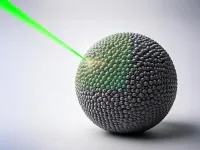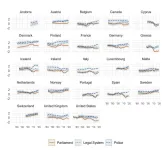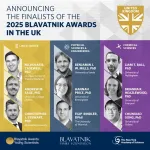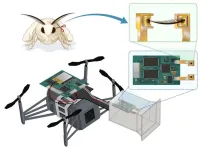(Press-News.org)
Illustration
A quantum "miracle material" could support magnetic switching, a team of researchers at the University of Regensburg and University of Michigan has shown.
This recently discovered capability could help enable applications in quantum computing, sensing and more. While earlier studies identified that quantum entities called excitons are sometimes effectively confined to a single line within the material chromium sulfide bromide, the new research provides a thorough theoretical and experimental demonstration explaining how this is connected to the magnetic order in the material.
Chromium sulfide bromide is exciting to quantum researchers because it can support nearly any way information is physically encoded: in electric charge, photons (light), magnetism (electron spins) and phonons (vibrations, such as sound).
"The long-term vision is, you could potentially build quantum machines or devices that use these three or even all four of these properties: photons to transfer information, electrons to process information through their interactions, magnetism to store information, and phonons to modulate and transduce information to new frequencies," said Mackillo Kira, U-M professor of electrical and computer engineering.
One of the ways chromium sulfide bromide could encode quantum information is in excitons. An exciton forms when an electron is moved out of its "ground" energy state in the semiconductor into a higher energy state, leaving behind a "hole." The electron and hole are paired together, and that collective state is an exciton.
The excitons are trapped in single layers by chromium sulfide bromide's unusual magnetic properties. The material is made up of layers just a few atoms thick, like molecular phyllo pastry. At low temperatures under 132 Kelvin (-222 Fahrenheit), the layers are magnetized—the spins of the electrons align with one another. The direction of the magnetic field switches to the opposite direction from one layer to the next. This is an antiferromagnetic structure.
Above 132 Kelvin, the material isn't magnetized—the heat keeps the electron spins from staying aligned, so they point in random directions. In the unmagnetized state, the excitons aren't trapped but extend over multiple atomic layers, making them three-dimensional. They can also move in any direction.
When the antiferromagnetic structure confines excitons to a single atomic layer, the excitons are further restricted to a single line—a single dimension—because they can easily move along only one of the two axes of the plane. In a quantum device, this confinement helps quantum information last longer because the excitons are less likely to collide with one another and lose the information they carry.
"The magnetic order is a new tuning knob for shaping excitons and their interactions. This could be a game changer for future electronics and information technology," said Rupert Huber, professor of physics at the University of Regensburg in Germany.
The experimental team, led by Huber, produced excitons inside a sample of chromium sulfide bromide by hitting it with pulses of infrared light just 20 quadrillionths of a second long. Then, they used another infrared laser with less energetic pulses to nudge the excitons into slightly higher energy states. In this way, they discovered that there are two variations of the excitons with surprisingly different energies—when normally, they would have identical energies. This splitting of an energy state is known as fine structure.
The team also explored how the material varies in space by shooting those less energetic pulses along two different axes within the material to probe the inner structures of excitons. This approach revealed the highly direction-dependent excitons, which could either be confined to a line or expanded in three dimensions. These configurations can be adjusted based on the magnetic states, switchable through external magnetic fields or temperature changes.
"Since the electronic, photonic and spin degrees of freedom are strongly intertwined, switching between a magnetized and a nonmagnetized state could serve as an extremely fast way to convert photon and spin-based quantum information," said Matthias Florian, U-M research investigator in electrical and computer engineering and co-first author with Marlene Liebich, a Ph.D. candidate in physics at the University of Regensburg.
The theory team, led by Kira, explained these results with quantum many-body calculations. The calculations used the structure of the material to systematically predict the exceptionally large fine-structure splitting in the magnetically ordered material and the transitions between the two exciton states when the material transitioned in and out of magnetic order. They also confirmed that the transition from one-dimensional to three-dimensional excitons accounted for the substantial changes observed in how long excitons could go without colliding, as the larger and more mobile excitons have more opportunities to collide.
One of the big questions the team plans to pursue is whether these excitons embodied in charge separation can be converted to magnetic excitations embodied in electron spins. If it can be done, it would provide a useful avenue for converting quantum information between the very different worlds of photons, excitons and spins.
The research was supported by the German Research Foundation, National Science Foundation, Air Force Office of Scientific Research and U-M's Advanced Research Computing resources.
Researchers from the University of Chemistry and Technology Prague, in the Czech Republic, and Dresden University of Technology, in Germany, also contributed to the study.
Study: Controlling Coulomb correlations and fine structure of quasi-one-dimensional excitons by magnetic order (DOI: 10.1038/s41563-025-02120-1)
END
Magnetic switch traps quantum information carriers in one dimension
Innovations in quantum sensing and computing could follow the discovery of how chromium sulfide bromide responds to magnetic fields
2025-02-19
ELSE PRESS RELEASES FROM THIS DATE:
Using light to activate treatments in the right place
2025-02-19
Acting in the right place at the right time is the key to effective medical treatment with minimal side effects. However, this feat remains difficult to achieve. Biologists and chemists at the University of Geneva (UNIGE) have succeeded in developing a tool that controls the location at which a molecule is activated by a simple pulse of light lasting only a few seconds. Tested on a protein essential for cell division, this system could be applied to other molecules. The potential applications are vast, both in basic research and in improving ...
Democracy in crisis: Trust in democratic institutions declining around the world
2025-02-19
New research from the University of Southampton has found that trust in representative institutions, such as parliaments, governments and political parties, has been declining in democratic countries around the world.
The study, published in The British Journal of Political Science, presents the largest and most comprehensive analysis of trends in political trust worldwide to date. It brings together results from 3,377 surveys covering 143 countries between 1958 and 2019, representing over five million survey respondents.
Whereas trust in representative institutions is generally in decline, trust in non-representative institutions ...
Finalists announced for the 2025 UK Blavatnik Awards for Young Scientists
2025-02-19
19 February 2025 – London – The Blavatnik Family Foundation and The New York Academy of Sciences today announced the Finalists for the eighth Blavatnik Awards for Young Scientists in the United Kingdom. The Awards recognise scientific advances by UK researchers across Life Sciences, Chemical Sciences, and Physical Sciences & Engineering.
On Wednesday, 4 March, Professor Shitij Kapur, FMedSci, Vice-Chancellor & President, King’s College London, will announce the three 2025 Laureates at a gala dinner and awards ceremony. The three Laureates will each receive an unrestricted award of £100,000 (US$126,000). ...
Bio-hybrid drone uses silkworm moth antennae to navigate using smell
2025-02-19
Conventional drones use visual sensors for navigation. However, environmental conditions like dampness, low light, and dust can hinder their effectiveness, limiting their use in disaster-stricken areas. Researchers from Japan have developed a novel bio-hybrid drone by combining robotic elements with odor-sensing antennae from silkworm moths. Their innovation, which integrates the agility and precision of robots with biological sensory mechanisms, can enhance the applicability of drones in navigation, gas sensing, and disaster response.
Technological advances have led to the development of drones with diverse applications, ...
Do seizures in newborns increase children’s risk of developing epilepsy?
2025-02-19
Seizures in newborns are one of the most frequent acute neurological conditions among infants admitted to neonatal care units. A study published in Developmental Medicine & Child Neurology indicates that newborns experiencing such neonatal seizures face an elevated risk of developing epilepsy.
For the study, investigators analyzed data on all children born in Denmark between 1997 and 2018, with the goal of comparing the risk of epilepsy in children with and without neonatal seizures.
Among 1,294,377 children, the researchers identified 1,998 who experienced neonatal seizures. The cumulative risk of epilepsy was 20.4% among children with neonatal seizures compared with 1.15% among children ...
Does the brain produce estrogen to control appetite?
2025-02-19
Although a woman’s ovaries produce the most estrogen, various types of estrogen are also synthesized throughout different tissues in the body, including the brain’s neurons. New research in The FEBS Journal indicates that such neuroestrogens help suppress appetite.
Knowing that the enzyme aromatase is important for the production of estrogens, investigators depleted or knocked out the gene encoding aromatase in mice, so that the animals were unable to synthesize estrogens in a systemic or body-wide manner. These mice demonstrated increased food intake and body weight compared with their aromatase-expressing counterparts. Restoring aromatase expression specifically ...
Would the prohibition of menthol cigarettes cause more harm than good?
2025-02-19
New research published in Health Economics indicates that a national prohibition of menthol cigarettes in the United States could increase the number of people who attempt to quit smoking but also support an illegal menthol cigarette market.
For the research, 639 adult menthol smokers made hypothetical choices between menthol and non-menthol cigarettes, menthol and non-menthol e-cigarettes, and attempting to quit. Participants were presented with situations where menthol cigarettes and menthol e-cigarettes were described as either legal, prohibited but available under-the-counter and online from retailers who continue ...
What are the benefits and harms of aggressive blood pressure lowering in older adults with different characteristics?
2025-02-19
Results from the Systolic Blood Pressure Intervention Trial (SPRINT) have supported lower blood pressure targets among community-dwelling older adults with hypertension to reduce the risk of cardiovascular disease and early death, but intensive blood pressure lowering can also increase risks of developing acute kidney injury and experiencing dangerously low blood pressure. A recent analysis in the Journal of the American Geriatrics Society looked closely at the benefits and harms of intensive blood pressure lowering in patients with different characteristics.
The analysis found that nearly all older adults in SPRINT had a positive ...
Why is Japanese knotweed so highly invasive?
2025-02-19
Research published in New Phytologist provides insights into why the invasive plant Japanese knotweed is so successful at outcompeting native plants.
Japanese knotweed (Reynoutria japonica), which is native to eastern Asia and is a highly invasive plant species across Europe and North America, is known to damage infrastructure and ecosystems. By comparing growth and reproduction traits of introduced plants with native plants, investigators discovered that introduced plants had gained the ability to reproduce faster by clonal propagation, a method ...
How will China’s reformed standards strategy affect corporate labor employment?
2025-02-19
The Chinese government is phasing in reforms for many technical standards that shape the products and services used by consumers around the world. While China has primarily depended on unilateral government authority for developing its standard system, the reforms would also incorporate market economies. New research published in Contemporary Economic Policy examined the impact of these reforms on corporate labor employment.
The study’s findings indicate that comprehensive standardization reform facilitates an increase in corporate labor employment by reducing transaction costs, enhancing operational efficiency, and improving the financing environment. The most profound impacts ...
LAST 30 PRESS RELEASES:
Scalable and healable gradient textiles for multi‑scenario radiative cooling via bicomponent blow spinning
Research shows informed traders never let a good climate crisis go to waste
Intelligent XGBoost framework enhances asphalt pavement skid resistance assessment
Dual-function biomaterials for postoperative osteosarcoma: Tumor suppression and bone regeneration
New framework reveals where transport emissions concentrate in Singapore
NTP-enhanced lattice oxygen activation in Ce-Co catalysts for low-temperature soot combustion
Synergistic interface engineering in Cu-Zn-Ce catalysts for efficient CO2 hydrogenation to methanol
COVID-19 leaves a lasting mark on the human brain
Scientists use ultrasound to soften and treat cancer tumors without damaging healthy tissue
Community swimming program for Black youth boosts skills, sense of belonging, study finds
Specific depressive symptoms in midlife linked to increased dementia risk
An ‘illuminating’ design sheds light on cholesterol
Who is more likely to get long COVID?
Study showcases resilience and rapid growth of “living rocks”
Naval Research Lab diver earns Office of Naval Research 2025 Sailor of the Year
New Mayo-led study establishes practical definition for rapidly progressive dementia
Fossil fuel industry’s “climate false solutions” reinforce its power and aggravate environmental injustice
Researchers reveal bias in a widely used measure of algorithm performance
Alcohol causes cancer. A study from IOCB Prague confirms damage to DNA and shows how cells defend against it
Hidden viruses in wastewater treatment may shape public health risks, study finds
Unlock the power of nature: how biomass can transform climate mitigation
Biochar reshapes hidden soil microbes that capture carbon dioxide in farmland
Reducing saturated fat intake shows mortality benefit, but only in high-risk individuals
Manta rays create mobile ecosystems, study finds
Study: Mixed results in using lipoic acid to treat progressive multiple sclerosis
Norbert Holtkamp appointed director of Fermi National Accelerator Laboratory
New agentic AI platform accelerates advanced optics design
Biologists discover neurons use physical signals — not electricity — to stabilize communication
Researchers discover that a hormone can access the brain by hitchhiking
University of Oklahoma researcher awarded funding to pursue AI-powered material design
[Press-News.org] Magnetic switch traps quantum information carriers in one dimensionInnovations in quantum sensing and computing could follow the discovery of how chromium sulfide bromide responds to magnetic fields



